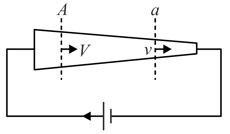Drift Velocity, Mobility and Their Relation with Electric Current
Drift Velocity, Mobility and Their Relation with Electric Current: Overview
This topic covers concepts, such as, Microscopic View of Electric Current, Drift Velocity, Variation of Drift Velocity in Non-uniform Cross-section Wire & Variation of Electric Field in Non-uniform Cross-section Wire etc.
Important Questions on Drift Velocity, Mobility and Their Relation with Electric Current
Two conducting wires X and Y of same diameter but different materials are joined in series across a battery. If the number density of electrons in X is twice that in Y, find the ratio of drift velocity of electrons in the two wires would be:
The current of a conductor flowing through a conductor in terms of the drift speed of electrons is (the symbols have their usual meanings)
Derive an expression for the resistivity of a good conductor, in terms of the relaxation time of electrons.
Two metallic wires of the same material have the same length but cross-sectional area is in the ratio . They are connected (i) in series and (ii) in parallel. Compare the drift velocities of electrons in the two wires in both the cases (i) and (ii).
The number density of free electrons in a copper conductor is How long does an electron take drift from one end of a wire 3.0 m long to its other end? The area of cross-section of the wire is and is carrying a current of 3.0 A.
The number density of free electrons in a copper conductor is estimated at How long does an electron take to drift from one end of a wire 3.0 m long to its other end? The area of cross-section of the wire is and it is carrying a current of 3.0 A.
The relation between current and drift velocity is
The number density of free electrons in copper is nearly . A copper wire has its area of cross-section and is carrying a current of . The drift speed of the electrons is _____.
A current of flows through a wire of cross-sectional area . The number of free electrons in a cubic meter are . The drift velocity of the electrons is _____
(given, charge on electron ).
In a metallic conductor, under the effect of applied electric field, the free electrons of the conductor
Average time between successive collisions for an electron for a conductor under a certain potential difference is 2 × 10-14 s. The mobility of electron in metal conductor is (mass of electron = 9.1 × 10-31 kg)
Suppose a current carrying wire has a cross sectional area that, gradually become smaller along the wire, has the shape of a very long cone as shown in figure. Choose the correct statement:

A. The drift velocity of electrons decreases with the increase in the temperature of conductor.
B. The drift velocity is inversely proportional to the area of cross-section of given conductor.
C. The drift velocity does not depend on the applied potential difference to the conductor.
D. The drift velocity of electron is inversely proportional to the length of the conductor.
E. The drift velocity increases with the increase in the temperature of conductor.
Choose the correct answer from the options given below:
A conductor has non-uniform cross-section as shown in figure. It is carry current I through it then drift velocity at point and will be related as

Find the current flow through a copper wire of length , area of cross-section , when connected to a battery of . (Take, electron mobility is , charge on an electron is and density of electrons in copper is )
Relation between drift velocity of electron and thermal velocity of electron at room temp is expressed as
The current in a copper wire is increased by increasing the potential difference between its ends. Which one of the following statements regarding the number of charge carriers per unit volume in the wire and , the drift velocity of the charge carriers is correct?
A conductor of variable cross-section is connected across a battery. Let us consider two cross-sections and . Let and be drift speeds of electrons at those cross-sections respectively then

If is specific charge of an electron, find the momentum of all the free electrons (due to their drift velocity) per unit length of a straight conductor of uniform cross-section carries a current .
A metal wire is subjected to a constant potential difference. When the temperature of the metal wire increases, the drift velocity of the electron in it
